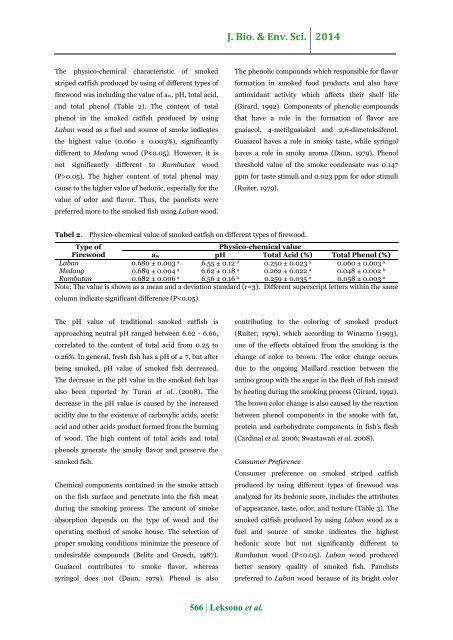Profile of traditional smoking striped catfish (Pangasius hypophthalmus Sauvage 1878) and firewood used in province of riau, Indonesia
Abstract This study was aimed to describe the profile of traditional striped catfish (Pangasius hypophthalmus Sauvage) smoking in Province of Riau, Indonesia. The study was collected data about the method of traditional smoking by survey. The survey was followed by the sampling and the laboratory analysis on the profile of produced smoked catfish and the best type of firewood used for fuel and smoke source. The laboratory analysis includes physico-chemical characteristics and sensory analyses. Results showed that fish smoking in Riau is applying direct hot smoking method. The smoking process is conducted in two stages. The first stage is roasting at the smoking temperature of 60-90°C for four hours, continued with drying stage at the smoking temperature of 40° C for about five hours. The product of smoked catfish was blackish brown, shiny, dry and clay textured, and the weight reduced to 31% from initial weight. The best type of firewood was Laban (Vitex pubescens Vahl). The smoked catfish using Laban firewood as smoke source showed the highest content of total phenols 0.060 ± 0.003%, with the value of aw 0.680 ± 0.05, and pH 6.65 ± 0.12. The smoked catfish produced was the most preferred by panelists, especially its appearance and odor, with the average of sensory value 7.4. This sensory value is above the minimum standard value 7.0 determined by the Agency of National Standard in Indonesia for smoked fish.
Abstract
This study was aimed to describe the profile of traditional striped catfish (Pangasius hypophthalmus Sauvage) smoking in Province of Riau, Indonesia. The study was collected data about the method of traditional smoking by survey. The survey was followed by the sampling and the laboratory analysis on the profile of produced smoked catfish and the best type of firewood used for fuel and smoke source. The laboratory analysis includes physico-chemical characteristics and sensory analyses. Results showed that fish smoking in Riau is applying direct hot smoking method. The smoking process is conducted in two stages. The first stage is roasting at the smoking temperature of 60-90°C for four hours, continued with drying stage at the smoking temperature of 40° C for about five hours. The product of smoked catfish was blackish brown, shiny, dry and clay textured, and the weight reduced to 31% from initial weight. The best type of firewood was Laban (Vitex pubescens Vahl). The smoked catfish using Laban firewood as smoke source showed the highest content of total phenols 0.060 ± 0.003%, with the value of aw 0.680 ± 0.05, and pH 6.65 ± 0.12. The smoked catfish produced was the most preferred by panelists, especially its appearance and odor, with the average of sensory value 7.4. This sensory value is above the minimum standard value 7.0 determined by the Agency of National Standard in Indonesia for smoked fish.
You also want an ePaper? Increase the reach of your titles
YUMPU automatically turns print PDFs into web optimized ePapers that Google loves.
J. Bio. & Env. Sci. 2014<br />
The physico-chemical characteristic <strong>of</strong> smoked<br />
<strong>striped</strong> <strong>catfish</strong> produced by us<strong>in</strong>g <strong>of</strong> different types <strong>of</strong><br />
<strong>firewood</strong> was <strong>in</strong>clud<strong>in</strong>g the value <strong>of</strong> aw, pH, total acid,<br />
<strong>and</strong> total phenol (Table 2). The content <strong>of</strong> total<br />
phenol <strong>in</strong> the smoked <strong>catfish</strong> produced by us<strong>in</strong>g<br />
Laban wood as a fuel <strong>and</strong> source <strong>of</strong> smoke <strong>in</strong>dicates<br />
the highest value (0.060 ± 0.003%), significantly<br />
different to Medang wood (P0.05). The higher content <strong>of</strong> total phenol may<br />
cause to the higher value <strong>of</strong> hedonic, especially for the<br />
value <strong>of</strong> odor <strong>and</strong> flavor. Thus, the panelists were<br />
preferred more to the smoked fish us<strong>in</strong>g Laban wood.<br />
The phenolic compounds which responsible for flavor<br />
formation <strong>in</strong> smoked food products <strong>and</strong> also have<br />
antioxidant activity which affects their shelf life<br />
(Girard, 1992). Components <strong>of</strong> phenolic compounds<br />
that have a role <strong>in</strong> the formation <strong>of</strong> flavor are<br />
guaiacol, 4-metilguaiakol <strong>and</strong> 2,6-dimetoksifenol.<br />
Guaiacol haves a role <strong>in</strong> smoky taste, while syr<strong>in</strong>gol<br />
haves a role <strong>in</strong> smoky aroma (Daun, 1979). Phenol<br />
threshold value <strong>of</strong> the smoke condensate was 0.147<br />
ppm for taste stimuli <strong>and</strong> 0.023 ppm for odor stimuli<br />
(Ruiter, 1979).<br />
Tabel 2.<br />
Physico-chemical value <strong>of</strong> smoked <strong>catfish</strong> on different types <strong>of</strong> <strong>firewood</strong>.<br />
Type <strong>of</strong><br />
Physico-chemical value<br />
Firewood<br />
aw pH Total Acid (%) Total Phenol (%)<br />
Laban 0.680 ± 0.003 a 6.55 ± 0.12 a 0.250 ± 0.023 a 0.060 ± 0.003 a<br />
Medang 0.689 ± 0.004 a 6.62 ± 0.18 a 0.262 ± 0.022 a 0.048 ± 0.002 b<br />
Rambutan 0.682 ± 0.006 a 6.56 ± 0.16 a 0.259 ± 0.035 a 0.058 ± 0.003 a<br />
Note: The value is shown as a mean <strong>and</strong> a deviation st<strong>and</strong>ard (r=3). Different superscript letters with<strong>in</strong> the same<br />
column <strong>in</strong>dicate significant difference (P





![Review on: impact of seed rates and method of sowing on yield and yield related traits of Teff [Eragrostis teff (Zucc.) Trotter] | IJAAR @yumpu](https://documents.yumpu.com/000/066/025/853/c0a2f1eefa2ed71422e741fbc2b37a5fd6200cb1/6b7767675149533469736965546e4c6a4e57325054773d3d/4f6e6531383245617a537a49397878747846574858513d3d.jpg?AWSAccessKeyId=AKIAICNEWSPSEKTJ5M3Q&Expires=1715306400&Signature=Boy9GRmC7gC3kxJTshn35NZO4MI%3D)












